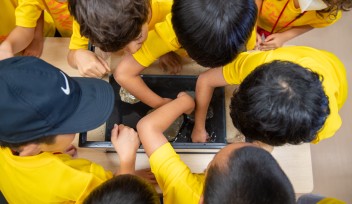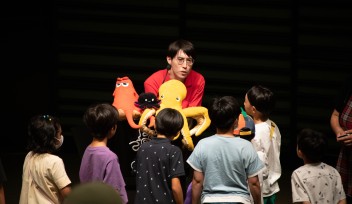Curiosity, creativity, and courage at the 13th annual SCORE! competition

The spacious main auditorium of the Okinawa Institute of Science and Technology (OIST) could barely contain the excitement. Countless hours spent over the summer designing experiments and analyzing data in their free time had culminated in these presentations. And now, after a whole day of presenting their research in front of not just their peers and teachers, but also internationally renowned scientists, the high school teams from across Okinawa Prefecture were now waiting for the final verdict from the five judges. Which team would earn the first prize: a study trip to the United States, where they would experience cutting-edge science and meet world-class research communities face-to-face?
Earlier that day, the 13th annual SCORE! competition was introduced by Prof. Thomas Busch, OIST’s Dean of Graduate School, who had set the tone for the day: “We believe science is the greatest team effort, and it takes curiosity from people around the world to make real change,” he said, “and your curiosity led you to enter this competition. Your passion helped you create an exciting project with interesting results.”
Following these welcoming remarks, Ms. Yukino Kinjo, CEO of the tourist beach clean-up project Manatii, held an honest talk on the best part of driving innovation through entrepreneurship. “Don’t worry about quitting ideas if they do not work out. There will always be new opportunities. People who try consistently will exceed through hard work - keep learning, keep growing, and keep collaborating,” as she said.

The competition was hosted by FM Okinawa radio host David Shen. Before unleashing the teams onto the stage, he coaxed the entire hall to stand and follow his lead in a series of stretches. With the nervousness dialed down, the first school team stepped onto the stage – and the presentations began.
Many teams took the lessons learnt at school and applied them to the phenomena of daily life, mixed in with a healthy curiosity and a strong desire to create positive change. For example, the Koyo High School team created plaster for use in construction with discarded eggshells, the contestants from Nago High School created an optical brightener for school uniforms using millipedes found in the forests around their school, and students from Urasoe High School spun silk from the cobwebs in their backyard.

The team of the Kyuyo High School, who presented on the antimicrobial properties of ant feces, emphasized value of the lessons learned throughout the process. “Before this, I had no experience in running my own project,” said one of the teammates after their presentation. “We did it all on our own. It was difficult, but also fun.”
Another team, from Okinawa Christian School International, elucidated the fungicidal properties of Precocene II, found in many plants. For them, the exciting part of the project was the freedom to take what they’ve previously learnt, dive deeper, and emerge with their own research and a realistic business case. As one of the members said, “it was a great experience to work on our own ‘serious’ research and then bring in the entrepreneurship and business side to it.”

The teams had independently chosen their subjects, designed their research, collected the data, created a business case, and presented their project. And for many of the teams, this was an opportunity to flex their academic English – as if presenting your science project in front of seasoned researchers didn’t take enough bravery!
Following the last presentation, the poster session began in the adjoining conference center. The room was alive with chatter as high schoolers mingled with graduate students, teachers, and professors, and lively discussions about the realities of the scientific process flourished. Among the poster presenters were a pair of brothers from Okinawa Christian School International, who had spent their summer coming up with a solution to the pressing issue of plastic waste on beaches: a 3D-printed PET-bottle shredder mounted on a wheelbarrow. “Our first prototypes failed completely,” one of the brothers admitted with a grin. But the two persisted, and through trial-and-error they exemplified the creativity of the scientific process with an entrepreneurial flair.

As the poster session drew to a close, the crowd was ushered back into the auditorium for the award ceremony. The five judges, which included OIST researchers, a start-up scientist, and experts from the Okinawa Prefectural Government, took the stage, and following a brief introduction by the senior judge Dr. Yohei Morita from OIST, announced the winners.
The 1st prize was awarded to the duo from the National Institute of Technology, Okinawa College, who had presented a low-cost disaster response safety helmet equipped with communication transceivers and a camera that, combined with a specialized AI model, allowed for quick assessment of the level of damage. They were motivated by the Noto earthquake, which cut off communications to several communities for days, and the judges lauded their dedication to saving lives with an innovative and feasible product, as well as their scientific rigor, having independently solicited feedback from experts at the Okinawa Meteorological Observatory.
The winning team went to California in the United States for a study trip together with their teacher, where they visited Google, Stanford University, a local high school, and other institutions related to science and technology. “This trip has really changed how I see my future,” said one of the team members. “One big thing I learned is that I shouldn’t worry too much about my English skills. It’s more important to take chances and get international experience as soon as I can.”

The five judges then took turns giving each of the presenting teams comprehensive feedback on their project, showing how the students can take the lessons learned from the hard work and interactions with the OIST scientists into their future careers. Events like this fuel the imagination and spark innovations: “Running their own passion project helps them develop their self-esteem,” said a teacher from the Okinawa Christian School International. “You can get an A+, but are you really ready for the world? Are you able to analyze a problem and find solutions? Can you go beyond the research, and present it and create awareness?”
Ms. Miki Nakazato is one of the organizers of SCORE! from the OIST Community Relations Section. “The creativity and entrepreneurship of the participants is amazing,” she said. “OIST is uniquely situated as an internationally oriented university in Okinawa and bringing together international researchers with the high school students and teachers have been truly inspirational for all of us!”
As the students and their teachers funneled out of the auditorium, the lights dimmed, and the echoes of applause began to fade. Yet the energy lingered, abuzz with gentle anticipation. What inspiring ideas would be presented on the stage next year?
To see more photos from the 13th annual SCORE!, please check out the Flickr album here.
For press enquiries:
Press Inquiry Form
















